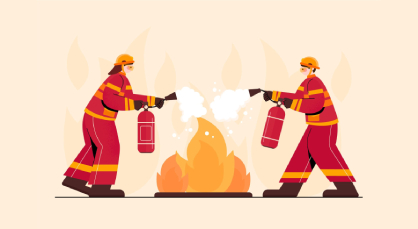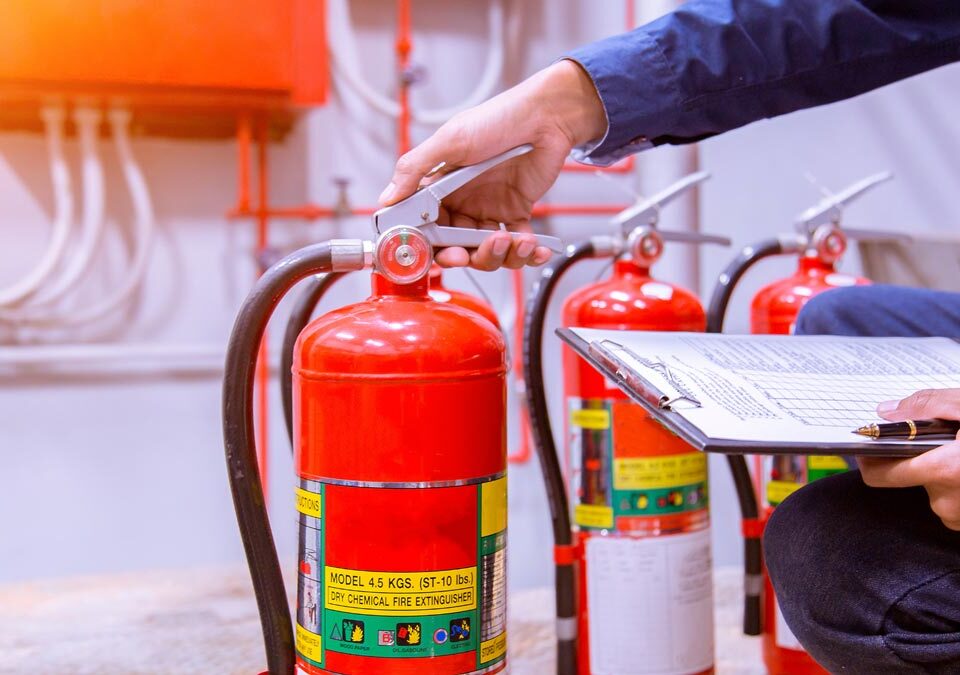6 Key Elements to Include in Your Safety Manual

Fire Safety Audit: The First Step to Prevent a Fire
May 20, 2023
Building Fire Safety Risks: 5 Steps From Negligence to Management
May 23, 20236 Key Elements to Include in Your Safety Manual
In today’s ever-changing work environment, safety should always be our utmost priority. A Safety Manual is an essential tool to ensure that your business operations run smoothly and your employees remain safe. In this article, we will present six key elements that should be included in your Safety Manual. By following this guide, your organization can minimize accidents and ensure that your workplace remains a safe and secure environment. So, get ready to learn the top six essential elements for your Safety Manual, and keep your employees secure. Incorporating the six key elements not only guarantees safety but shows your employees that you prioritize their well-being. With a comprehensive Safety Manual, you can create a secure workspace that increases employee satisfaction, minimizes accidents, and ultimately increases productivity.
Introduction
Are you worried about the safety of your employees in the workplace? Are you struggling to create a comprehensive Safety Manual for your organization? Look no further, as we have compiled a list of 6 key elements that every safety manual should include. In this article, we will explore fundamental information, roles and responsibilities, emergency procedures, incident investigation, safety training, and safe work practices. By following these guidelines in creating your safety manual, you can ensure the protection of your employees and provide them with a safe and healthy work environment. Read on to learn how to keep your workers safe and mitigate risks in the workplace
Fundamental Information:
The safety manual is an essential document for any business that is committed to maintaining a safe working environment. It outlines the policies, procedures, and practices that employees must follow to ensure their safety and wellbeing. The fundamental information section sets the foundation for the rest of the manual by introducing its purpose and scope.This section should begin with a clear statement of the organization’s commitment to safety. It should explain why the manual has been created, what it covers, and who it applies to. It is also important to define key terms and concepts related to workplace safety so that everyone has a shared understanding.
When it comes to ensuring workplace safety, everyone has a role to play. It is the responsibility of management to create a safe work environment, but employees must also do their part by following established safety procedures and reporting any hazards they encounter. Management must provide clear guidelines on what is expected of employees regarding safety, including proper use of equipment and adherence to safety protocols. Supervisors should ensure that each employee understands their specific responsibilities related to preventing accidents and injuries at work.
Employees have the responsibility to follow established procedures for safely performing their tasks while also being alert for potential hazards. They should report any unsafe conditions or behaviors they observe immediately so that corrective action can be taken promptly. By working together, everyone can contribute towards creating a safe work environment for all.
Emergency Procedures Section: In the event of an emergency, it’s crucial that employees know what steps to take to ensure their safety and the safety of others. This section of your safety manual should include a detailed outline of emergency procedures specific to your workplace.
Start by identifying potential emergencies, such as fires, natural disasters or hazardous material spills. Then, describe the actions employees should take in each scenario. For example, if there is a fire, they should know where the nearest exit is and how to evacuate quickly and safely. If there is a hazardous material spill, they should know how to contain the spill and alert appropriate personnel.
It’s important to also include instructions for reporting emergencies and who to contact in case of an emergency. Consider providing training exercises or drills so that employees can practice executing these procedures in a simulated environment. Investing time into creating comprehensive emergency procedures can save lives and reduce damage during crises at work.
When an accident or incident occurs in the workplace, it’s important to conduct a thorough investigation to determine the root cause and prevent similar incidents from happening in the future. The incident investigation section of your safety manual should outline specific procedures to follow when an incident occurs.The first step in incident investigation is to secure the scene and make sure that everyone involved is safe. Then, gather information about what happened by interviewing witnesses and reviewing any available documentation. It’s important to determine not only what happened but also why it happened so that appropriate corrective actions can be taken.
After gathering information, analyze the data and identify contributing factors that led up to the incident. Then, develop a plan for corrective actions that addresses those contributing factors. Finally, communicate your findings and recommended corrective actions to management and employees so that everyone is aware of what steps are being taken to prevent similar incidents from occurring in the future.
Safety Training is an essential component of any Safety Manual. It ensures that employees are aware of the potential hazards in their workplace and equipped with the necessary skills and knowledge to prevent accidents. A well-designed training program can also help to create a culture of safety throughout the organization.The first step in developing a successful Safety Training program is to identify the specific hazards that employees may encounter in their work environment. This could include anything from working with heavy machinery to handling hazardous materials. Once these hazards have been identified, it is important to develop training materials that are tailored to each specific hazard
Effective Safety Training should be engaging and interactive, rather than simply reading from a handbook or watching a video. Hands-on activities and scenario-based training can help employees better understand how to apply safety procedures in real-world situations. Regular refresher courses can also help reinforce these concepts and ensure that they remain top-of-mind for employees.
Establishing and implementing safe work practices is vital to the overall success of a safety program. Safe work practices should be developed collaboratively with employees and management as they are the ones who will be responsible for enacting them on a daily basis. The goal is to minimize hazards and prevent accidents or injuries from occurring.In order to develop effective safe work practices, it’s important to identify potential hazards in the workplace and then determine the best methods for eliminating or reducing those hazards. This may involve changes in equipment, procedures, or even personnel training. Employees should also be involved in identifying potential hazards and providing feedback on how to address them.
Once safe work practices have been established, it’s important that they are communicated clearly and effectively to all employees. This may involve training sessions, written directives, or even visual aids such as posters or signage. Regular reminders and updates can also help ensure that everyone stays informed about any changes or updates to the safe work practices.
By implementing effective safe work practices, employers can not only reduce accidents and injuries in the workplace but also increase productivity by creating a safer working environment where employees can focus on their jobs without fear of harm or injury.
Clear and effective communication about hazards is essential to maintaining a safe workplace. Hazard communication involves identifying and communicating potential dangers associated with work tasks, machinery, chemicals, and other hazardous materials. OSHA standard 1910.1200 requires employers to develop a hazard communication program that includes a written plan, labeling of hazardous materials, safety data sheets (SDSs), employee training, and more.To ensure effective hazard communication in your safety manual, include details on how you will identify and label hazardous materials in the workplace. Discuss how you will maintain SDSs for each hazardous material used or stored at your worksite. It’s also important to provide guidance on how employees can access this information easily when they need it.
Finally, don’t forget to incorporate guidance on employee training regarding the risks of working with hazardous materials in the workplace. Your safety manual should specify the frequency of training as well as any required documentation for proof of attendance or understanding. By prioritizing effective hazard communication in your safety manual, you can promote transparency and awareness within your workplace while ensuring everyone is safe from potential hazards.
Personal Protective EquipmentPersonal protective equipment, commonly known as PPE, is an essential aspect of workplace safety. This equipment is designed to protect employees from hazards and injuries that may occur while performing their job duties. PPE can include items such as gloves, safety glasses, hard hats, respirators, and more.
When developing your safety manual, it’s important to outline the specific types of PPE that are required for each job role and task. Provide detailed instructions on how to properly select, use, and maintain the equipment. Additionally, ensure that employees understand the importance of wearing their PPE at all times while working in hazardous conditions.
There will be many more elements be part of Safety Manual such as permit to work, Maintenance, Fire risk prevention, electrical safety, work at height etc, guidelines and processes shall be provided in it.
TSM TheSafetyMaster Private Limited provides following services
- Preparation of Safety Manual
- Training on Safety Manual
- Implementation of Safety Manual
- Safety Training on Safety Management System
- Implementation of Behaviour Safety
In conclusion, having a comprehensive safety manual is vital for any organization to ensure the safety of its employees. The six key elements discussed in this article provide a solid foundation for creating an effective safety manual. By following these guidelines, organizations can create a safe work environment and reduce the risk of accidents or injuries. Remember, safety should always be a top priority, and investing time and resources into developing a thorough safety manual is an investment worth making
TSM TheSafetyMaster® Private Limited
Unit No 221-451-452, SPL1/J, 2nd Floor, Sunsquare Plaza Complex, RIICO Chowk, Bhiwadi 301019, Rajasthan, India
Phone: +91 1493 22 0093/+91-124-4881109
Mobile: +91 7665231743/9413882016
Email: info@thesafetymaster.com




